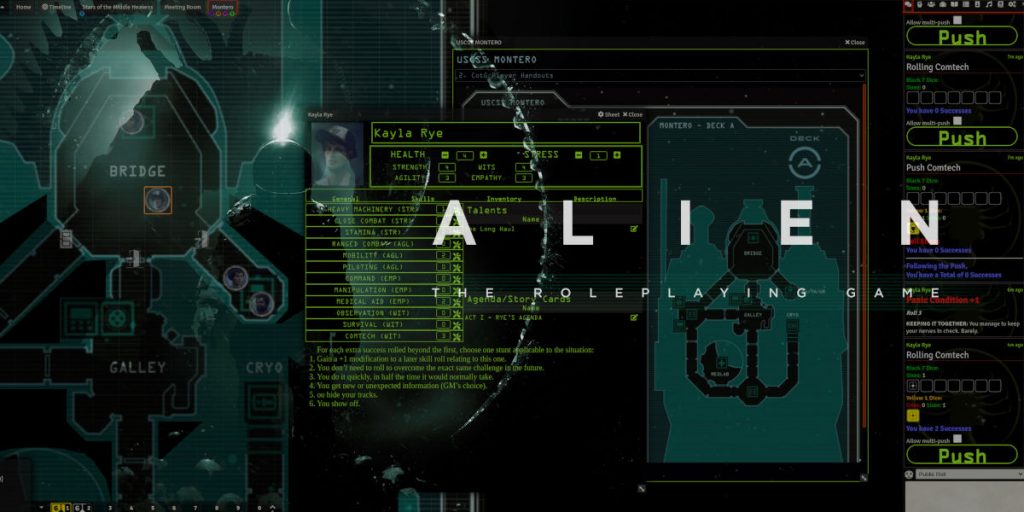There is no Cat

After finishing Pathfinder Strange Aeons last week, this was our first session of the Chariot of the Gods scenario for the Alien RPG. As well as starting a new game, we also switched to a new platform – using FoundryVTT since the game has a module available for the platform that includes everything needed for the starter campaign. Our GM (Game Mother) ran things from his laptop, which we connected to remotely, and it all seemed to go pretty smoothly once everyone had got used to things.
The starter adventure comes with five pre-generated characters, and since we had four players we each chose one and left the last as an NPC. The NPCs aren’t just a set of stats, but come with backgrounds and personalities. They also come with secret objectives which they need to try and achieve during the course of the game.
My character was Kayla Rye, a badly paid tech that seemed to be based on Brett from the original Alien film – always seeking for a pay rise or bonus. I’ve never come across the name Kayla before, and the character’s portrait wasn’t obviously male or female. A quick google though brought up some images that made me decide on female. Her main focus seemed to be to get some extra cash to pay the medical bills for her sick brother, which at least gave her a reason to be focused on money.
The rest of the crew of the USCSS Montero are:
- John Wilson – the company man
- Vanessa Miller – the ship’s captain
- Leah Davis – the ship’s pilot
- Lyrom Cham – another technician, and an NPC in our game
We were obviously missing a cat for the ship, and nobody seems to be an artificial person.
Set some years after the events of Alien 3, we started waking up from cold sleep aboard the ship, a Helium 3 hauler on its way from Anchorpoint Station to Sutter’s World.
After the usual roleplaying of waking up, getting showered and seeking coffee, we discovered that we were only part way through the route. So Miller went to talk to the ship’s computer Mother. Apparently we picked up a distress call and automatically dropped us out of FTL to investigate.
I get to make a ComTech check to find out where the distress call came from, and so we tried out the skill system. You have attributes and skills, and add them together to roll that many D6 – in my case 7. Each 6 is a success – which means even a total of 7 doesn’t have a great chance of success. There is an option to push a roll, which allows you to re-roll failed dice, at the cost of one stress point.
FoundryVTT nicely handles all this automatically, giving the chance to push a roll and automatically providing you a stress point. Each stress point has a chance of causing you to panic, but it also adds an extra die to your skill checks. However, a stress die also cause problems on a roll of a 1. So a greater chance of success as you become stressed, but also an increasing chance of panic.
We discovered that the distress signal was coming from another ship – which was rapidly approaching us at 4% of light speed on a collision course. At this point I had to clarify with the Game Mother whether this collision was an actual plot point, or just due to the game designers being completely unaware of just how big space was and that the chance of collision was pretty much zero. It was clarified that it was the latter. If that hadn’t been clarified then we could have gone down various rabbit holes of trying to figure out how such an extremely unlikely collision could have been deliberately engineered.
After discussion about pay and salvage rights, the company man Wilson confirms that we’d get paid a bonus if we rescue the other ship, so we head off after it, eventually matching velocity and getting ready to board.
It is the USCSS Cronus, a much smaller exploratory vessel that also belongs to the Wayland Yutani company. The session ends with us tooling up and getting ready to head across to look for survivors.
The first half of the session had been spent getting used to the new virtual tabletop system – with people figuring out how to make use of their character sheets, assign equipment to themselves and generally roll dice and find player handouts.
As a player, the ability to change scenes yourself was a big advantage over Roll20, but the character sheets were maybe just as clunky, though more functional as well. Having run something in Foundry before was a great help – the fact that journal objects aren’t visible to players unless they select the right tool really isn’t at all obvious to a GM who can see them all the time.
So far the game system itself seems reasonable – a skill based system with aspects to reflect the horror nature of the setting. The adventure seems like it’s following a plot line similar to the original film, but this isn’t necessarily bad. It’s probably almost expected. If there wasn’t some form of derelict location, with the opportunity for face huggers and faceless corporations, then it wouldn’t be much of an Alien scenario after all. Maybe the new ship will have a cat that needs rescuing.